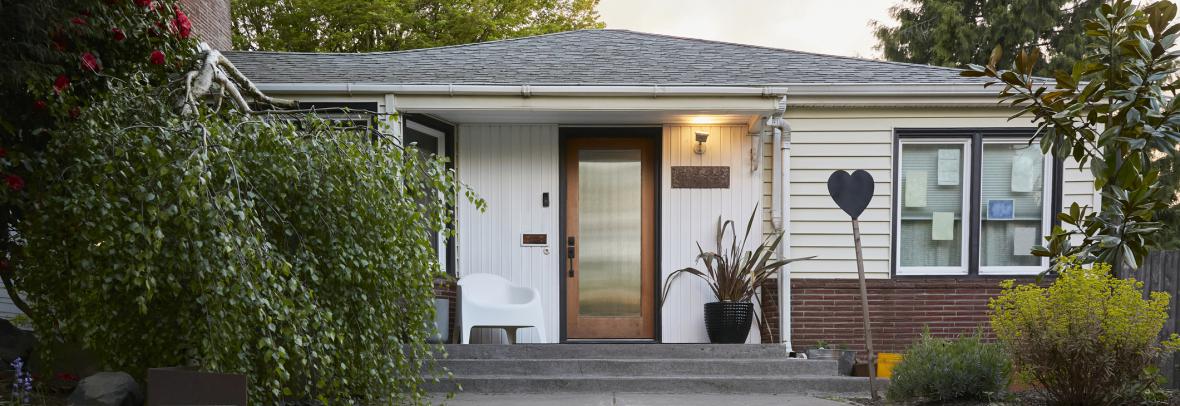
Teardowns Return as the Cost of Land Rises
A growing number of S. Fla.’s midcentury homes – basic one-story cinderblocks – are being torn down and replaced as the amount of buildable land disappears.
WEST PALM BEACH, Fla. – They built their homes as stalwart as their ethos – all cinderblock and right angles, no nonsense, no frills. It was the style of the Greatest Generation who found their way to South Florida after the Second World War by way of Morrison Field, now Palm Beach International Airport.
Squat and plain, the single-story houses filled gaps between the 1920s Spanish Mediterranean romantics and the balconied Monterey Colonials in West Palm Beach.
But with vacant dirt east of Interstate 95 scarce, a pandemic growth spurt, and a downtown business boom, the 1950s-era homes are toppling like sandcastles at high tide. Larger, taller, more efficient structures are the new tenet.
“We’ve had four teardowns in the past two years,” said Sunshine Park Neighborhood Association President Dennis Perry at a West Palm Beach Historic Preservation Board meeting in January. “We are very concerned about new construction, some of which is incompatible in size, scale and proportion.”
Sunshine Park, a century-old community of 130 properties south of downtown, is pursuing historic designation after seeing unsettling demos and rebuilds, including the razing of a 1920s-era mission-style house.
The Historic Preservation Board is a sentry for homes in the city’s 17 protected districts. But permit requests citywide for significant demolitions of parts, or all, of a single-family residence reached about 115 last year, a 49% increase over the average between 2018 and 2021, and a 68% jump from 2020, according to city records.
More than 1,300 historic reviews were conducted by city staff in 2021, up from 1,070 in 2020 and 950 in 2019.
And it’s not just the rectangular ranches and stripped-down “minimalist traditional” homes that are succumbing to the wrecking ball. A 1927 Spanish-style home with a stately tower and pecky-cypress ceilings in the South of Southern, or SoSo, neighborhood was approved for demolition last year. The home, which was not in a historic district, was bought in September for $2.2 million by a limited liability company.
West Palm Beach Historic Preservation Planner Friederike Mittner called the demo “heartbreaking.”
“We happened to see the permit and tried to call the owners,” Mittner said. “We made a pitch – designate it, move it – but there wasn’t interest.”
There were two distinct historical land booms in South Florida. The frenetic migration in the 1920s unloaded sunshine-seekers from Henry Flagler’s railroad into West Palm Beach by the scores. The ballooning population resulted in what The Palm Beach Post characterized in 1925 as “the most acute housing shortage in the city’s history.”
From 1920 to 1925 West Palm Beach’s property values increased from $13.6 million to $61 million. The boom was chilled by the hurricanes of 1926 and 1928.
The 1950s saw the return of World War II veterans and a migration south that spurred the post-war “infill homes” that grew between the more distinct 1920s architecture.
Amanda Skier, president and CEO of the Preservation Foundation of Palm Beach, and chairwoman of the West Palm Beach Historic Preservation Board, lives in the El Cid historic district in a 1955 concrete-block ranch-style home. She said at one time there were four in a row on her street. Two were demolished and one added a second floor.
“Mine is the last one,” said Skier, who worked with Mittner to individually designate her house to protect its historic integrity. “It tells an important story about the history and development of our area.”
Four blocks south of Skier in a carve-out pocket of El Cid that is not part of the historic district, a 1953 home was crunched into chunks and hauled away earlier this month.
Just eight houses west of the Intracoastal waterway, the property changed ownership twice in early 2021. It sold in January for $500,000, and then again in March for $768,750, according to Palm Beach County Property Appraiser records.
Owner Tom Cush, who is moving from New York to West Palm Beach, said he and his wife wanted to save the concrete block-and-stucco home, but it had mold inside. Their architect eventually told them it was cheaper to tear it down than to repair and remodel it.
“New roof, new plumbing, new electric. The kitchen was a Lilly Pullitzer pink and green,” said Cush, who at 6-foot-4 was also concerned about ceiling heights. “We were going to be left with a shell. They said you would be better off starting from scratch.”
The new 3,000-square-foot home will be built in the British West Indies style – two stories high with elements from 18th- and 19th-century architecture brought to the Caribbean by the British.
At the four-and-a-half-hour-long January historic preservation board meeting, six homes were on the agenda for demolition approval. Realtor and Flamingo Park resident Linda Cullen spoke against allowing the destruction of a 1946 home on Kanuga Drive where a developer wanted to split the lot and build two new houses. Dividing lots is a trend Mittner said she is seeing more of in the historic communities.
Cullen said the request was “simply a matter of taking advantage of the market,” and that a historic home shouldn’t be sacrificed for selfish reasons.
The preservation board agreed, denying the demolition request.
But they did allow for two key teardowns of homes next to each other on Flagler Drive along the Intracoastal Waterway. The demolitions and rebuilds will add to already weighty changes in appearance and property values on the waterfront.
Neither structure – built in 1960 and 1952 – contributes to the historic designation of El Cid. The demolition of the 1952 home near the corner of Flagler and Valencia Road was not considered “irreparable to the district or the city.”
But the lack of historic designation was likely by choice.
As many as 35 homes were allowed to opt out of historic status in a 2008 resurvey of the neighborhood to add homes that weren’t old enough to qualify when the neighborhood was originally designated in 1995. That opt-out left many 1950s-era homes vulnerable to annihilation.
El Cid resident Nancy Pullum bristled at the idea the teardowns would not cause irreparable damage.
“I’m alarmed at the casual write-off of midcentury houses because of market pressures,” said Pullum, who has lived in El Cid for more than three decades. “To say they are no loss is something I object to strongly. They are part of the fabric of the neighborhood.”
Steve Simpson, an El Cid resident and Realtor, said extra pressure is being put on West Palm Beach’s historic communities because buyers are clamoring for homes east of I-95. Some millionaires who once eyed Palm Beach have been priced out and consider a home near the water in West Palm Beach the next best thing, he said.
Also, he’s recently had clients who are moving from Palm Beach to West Palm Beach after getting unsolicited offers on their island homes that they found hard to refuse.
“From I-95 east, we are in for a wild ride,” he said. “We’re witnessing something very unique in the history of West Palm Beach and we just have to manage it properly.”
That likely means more lengthy meetings of the historic preservation board.
“People do like the character of the neighborhood,” Pullum said about El Cid. “But at what point do you lose the sense of charm that originally attracted them?”
© Copyright 2022 Palm Beach Newspapers, Inc.
